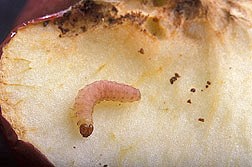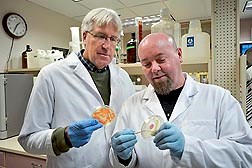Yeast and Sugar Lure Pest to Beneficial Virus
Common baking ingredients may offer a way to bolster the effectiveness of Cydia pomonella granulovirus (CpGV), a natural insect pathogen that’s been commercially formulated to kill codling moth larvae, a pest of apple, pear, walnut, and other orchard crops.
Studies by Agricultural Research Service scientists and their Swedish colleagues show that adding two feeding stimulants—brewer’s yeast and brown sugar—to the spray formulations can increase the pests’ contact with, and ingestion of, the lethal insect virus, sparing more fruit from harm.
The scientists’ investigations are part of a broader research effort to incorporate novel ingredients, or “adjuvants,” that will improve CpGV’s performance as a biobased alternative to broad-spectrum insecticides, which can be costly to apply and harmful to beneficial insects, as well.
|
|
Currently, CpGV is used on more than 370,000 acres of apples worldwide. But its effectiveness as a bioinsecticide can be diminished by exposure to ultra-violet light and by the larvae’s tendency to burrow into fruit to feed shortly after hatching, says entomologist Alan Knight, at ARS’s Fruit and Vegetable Insect Research Unit in Wapato, Washington.
In 2 years of field trials, the addition of sugar and brewer’s yeast to sprays of CpGV killed more larvae (83 percent) than virus-only formulations (55 percent) and water-only controls (17 percent). The treatments also reduced feeding injury to the apples in 1 of the 2 test years, notes Knight.
Sugar/virus combinations were less effective than yeast/virus combinations, which, in turn, were less effective than virus/yeast/sugar formulations.
“We believe the sugar helps the yeast to grow, creating attractive volatiles that stimulate feeding, and that increases larval death through greater contact with the virus,” Knight says.
Knight and Peter Witzgall, a professor of chemical ecology at the Swedish University of Agricultural Sciences in Alnarp, Sweden, came up with the yeast/sugar approach based on earlier findings that wild yeasts are important to larval health and survival. They found that some of the natural yeasts present on apple surfaces also grow in larval tunnels. There, the yeasts provide a nutritional boost to the insect’s diet and prevent molds from growing.
The researchers are evaluating other natural adjuvants to make the virus more effective. These include feeding stimulants, such as pear ester; unpasteurized corn steep liquor; and some wild yeast species, including Metschnikowia pulcherrima and Cryptococcus tephrensis.
The virus is a potent biopesticide, exacting an ugly toll on codling moth larvae that ingest it, but it is harmless to nonhost insects, fish, wildlife, livestock, pets, and humans.
Knight welcomes collaborators interested in commercially developing the sugar/yeast blend as an adjuvant for CpGV or for use in other pest control applications.—By Jan Suszkiw, Agricultural Research Service Information Staff.
This research is part of ARS National Program #304, Crop Protection and Quarantine.
"Yeast and Sugar Lure Pest to Beneficial Virus" was published in the March 2015 issue of Agricultural Research magazine.








